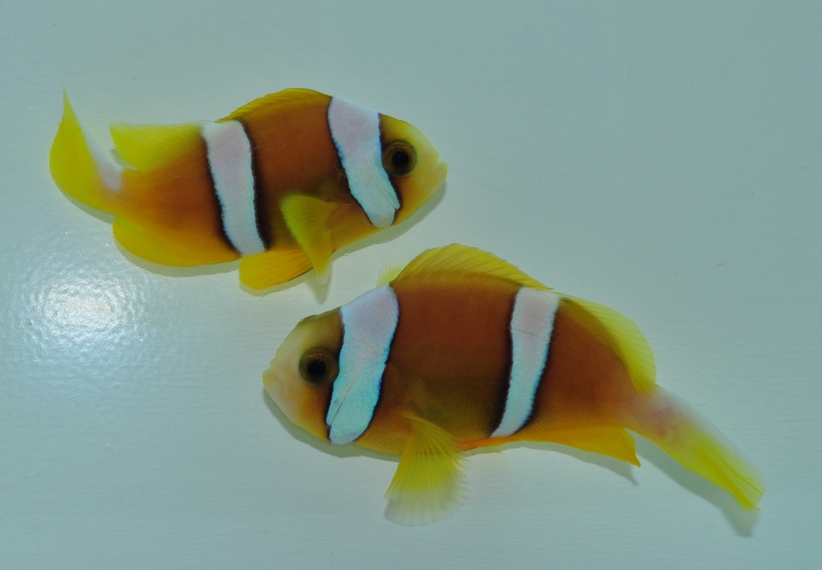The crew at Sustainable Aquatics has been continuing to push the boundaries of commercial captive breeding with two new introductions made late last week: Allardi clownfish, Amphiprion allardi and the Molly Miller blenny, Scartella cristata. Neither fish is a “species first”, both have been propagated in the past. What’s new is that they are now available as captive-bred through the traditional commercial basis (you’re not going to have to seek out some hobbyist breeder’s basement to find them).
The first is the commercial offering of captive-bred Amphiprion allardi, the Allardi Clownfish from East Africa. This species is a close relative of the infamously difficult Blue Stripe Clownfish, A. chrysopterus, but is perhaps a more ideal fish for commercial propagation as juveniles are more attractive than the utterly drab baby Blue Stripes. This may be the first commercial offering of the species as captive-bred; I am aware of only one other breeding occurrence with this exceptionally beautiful member of the Clarkii-complex.

Sustainable Aquatics has years invested in breeding the Allardi clownfish…a common story of time and patience that becomes more familiar when you delve into clownfish breeding. Matthew Carberry credits the move to a larger aquarium as a possible factor for getting over the hump and he had this to share:
“The broodstock were purchased from Live Aquaria (Diver’s Den) about 4 years ago I think. I’d credit that as a good start for success; we have several pairs that have originated from the Diver’s Den, and I can always count on getting healthy fish.We kept them in a 30 breeder with a BTA for a few years before moving them into a 600g reef “pool” that serves as our “proof of concept” tank for the SI project–it houses some (now very large) tank-raised fish…The pair was put there with their anemone to see if a more natural (large) tank with better flow, lighting, etc would help them to spawn, and a few months later, they did. I realize it’s not exactly a big splash for the trade, but it’s another species made available through the efforts of tank-breeding, and there will be a limited number of people looking for something different—maybe a more “natural” species rarity rather than a selectively-bred designer fish. As far as rearing, Joe [Lichtenbert] is right; they’re clarkii; fast-growing and energetic”.

We beg to differ – adult Allardi are some of the most stunningly beautiful natural clownfish species available in the trade – deep mocha to black flanks with yellow fins, white tail, and striking blue bars. The Allardi clownfish is a species to be coveted. The juveniles that SA is raising are actually, surprisingly, divergent in their coloration. Some of the juveniles are initially turning out very light colored (like the ones pictured earlier), while others are already “dark” – a coloration that really sets off their markings and over-sized fins. Wild-caught juvenile Allardi almost always look like these dark juveniles.
The second addition to Sustainable Aquatic’s captive bred marine fish roster is Molly Miller Blennies, Scartella cristata.

Sustainable Aquatics seems to be embracing the notion of if it can be bred, we should try to offer it captive-bred. We’re pretty sure that wild caught Molly Millers are easily obtainable from the Caribbean and are relatively inexpensive, but there is something to be said for the notion of a fish like this being the perfect addition to a “zero impact” reef. For too long (and to this day) I can point to many of my aquariums and say “everything in there is captive bred, except the fish”. This gets us one step closer, and perhaps inspires the next breeder to do some other oddball fish. Plus, these captive-bred Molly Millers are potential pest-control godsends.
For the Blennies, which BTW are not a species first (someone did them before according to MBI records), Carberry tells us that the breeders in the audience should indeed be encouraged. ” I think a BRT [Black Round Tub] and some good rotifers should do the trick! They aren’t too demanding, but they do eat a LOT of food. The eggs incubate well and can be moved and put under an airstone in the hatching/larval tank whenever it’s convenient.” Sounds like a great fish for a hobbyist to springboard, and starting with captive-bred broodstock from SA may make it even easier.




